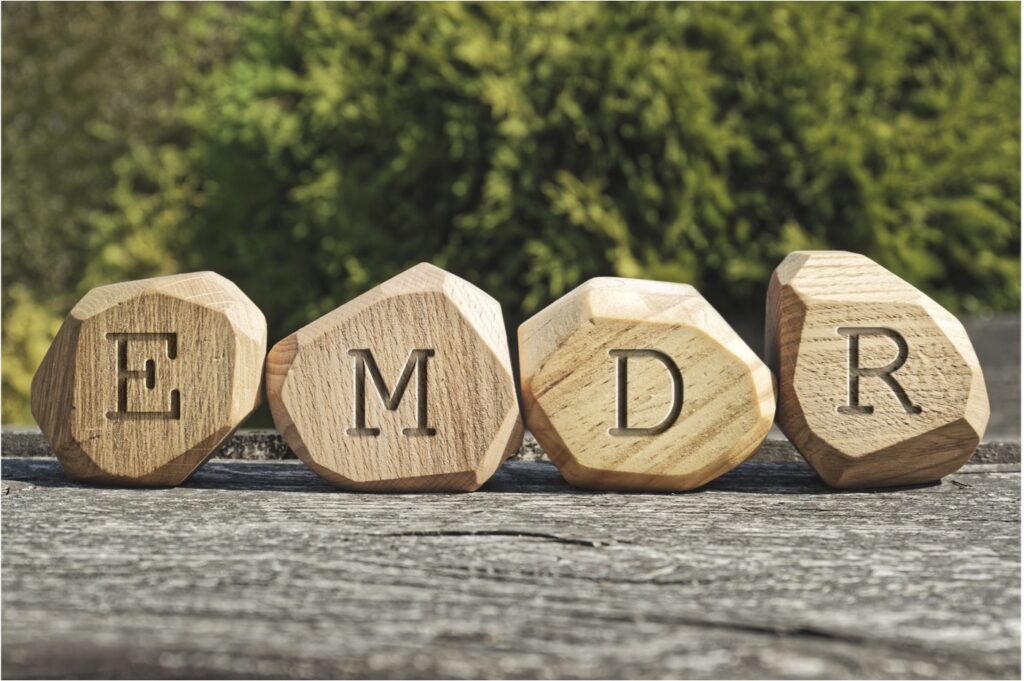Eye-Movement and Desensitisation and Reprocessing (EMDR) is a comprehensive psychotherapy specifically designed to help people who have experienced traumatic or upsetting events or who have symptoms of Post-Traumatic Stress Disorder (PTSD). It’s based on the idea that traumatic memories can be stored in the brain differently from all other
memories, making it difficult for us to process and integrate them.
EMDR Therapy uses bilateral stimulation to combat this. This involves stimulating either side of your brain in an alternating left-right fashion to help you access your subconscious mind so you can process and integrate the painful memories stored there.
In addition to trauma and PTSD, EMDR Therapy has an emerging evidence base showing it to be an effective treatment for a wide range of other common mental health problems including anxiety and depression, phobias, grief, Obsessive Compulsive Disorder (OCD), and addiction.
What Happens During an EMDR Session?
EMDR therapy has eight phases. Each session will look a little different depending on where you’re up to and the number of sessions needed varies from one person to the next. Let’s explore each of the eight phases together…
Phase 1 – History Taking
I will begin by taking a comprehensive history about your current symptoms and past experiences. This will help me understand the difficulties you’re currently experiencing and how they’re impacting your life. You will usually be asked to complete a timeline of your distressing or traumatic experiences. This will give us some insight into how your past experiences may have contributed to the problems you’re experiencing in the here and now. At the end of the history taking phase,
we’ll have identified a ‘target’ memory on which to focus, as well as your hopes and goals for the future related to this target.
Phase 2 – Preparation
Appropriate preparation is essential to ensure EMDR Therapy is effective. During this phase, we’ll work together to identify coping strategies or ‘resources’ designed to help you remain in what’s known as your ‘window of tolerance’. In this state, your arousal levels are regulated so emotions can be activated without becoming so overwhelming that trauma processing stops.
Phase 3 – Assessment
The assessment phase is used to activate the target memory you agreed to process during phase one. Activating the distressing or traumatic memory allows it to be brought into the working memory to be processed. I will guide you through the activation by asking questions about the memory, images and thoughts it evokes, the physical sensations and emotions you experience, and the level of distress it causes you now. Don’t worry if you find a traumatic memory too distressing or difficult to talk about. We can take a ‘blind to therapist approach’ which removes the need to go into explicit detail about your target memory.
Phase 4 – Desensitisation
This is the phase that’s commonly mistakenly to be EMDR Therapy, when in fact all eight phases make up this therapeutic approach. During desensitisation, I’ll guide you through the re-processing of your target memory. You will be asked to recall that target while simultaneously engaging in a form of bi-lateral stimulation (BLS), such as eye movements, butterfly hugs or tapping. This can be done manually or by using devices such as a light bar or tactile (tapping) devices. After a short ‘set’ of BLS, you will be asked to notice what comes up for you. This will be a brief check-in before being asked to ‘go with that’ so your re-processing can continue without distraction. EMDR is different from other talking therapies in that you don’t need to go into a lot of detail in between sets. You just need to give me a brief ‘headline’.
Phase 5 – Installation
Once you have successfully re-processed the target memory, phase five seeks to replace the negative thoughts, emotions and beliefs previously associated with that memory by reinforcing the positive thoughts, emotions and beliefs you have now.
Phase 6 – Body Scan
During this phase, I will ask you to focus on the target memory and notice any residual physical sensations you can feel in your body. Further reprocessing will then be completed until these sensations have resolved.
Phase 7 – Closure
It’s essential that all sessions are closed properly to ensure you feel safe and comfortable enough to leave the therapy session. This might include accessing some of the resources and grounding exercises we worked on in phase two.
Phase 8 – Re-Evaluation
At the beginning of each appointment, we’ll discuss anything that’s come up for you in between sessions. We’ll also chat about your most recently processed memory and ensure the associated distress is still low. This can help us determine whether the target memory reprocessing is complete.
How Does EMDR Therapy Work Online?
As well as wanting to understand how EMDR Therapy works, people are often curious about how it can be delivered remotely. The good news is, EMDR Therapy delivered online has been found to be just as effective as EMDR delivered in person. It also has the added benefit of removing certain barriers to therapy. For example, it can mean you’re able to access the therapist you really want, even if you live outside the area in which they practice. For EMDR to be successful online, all you need is access to a laptop, tablet or desktop computer, a stable internet connection and a quiet, private place in which to attend your session. The eight phases are delivered as described above, with the exception of phase four – bi-lateral stimulation. There are several ways BLS can be administered online. It’s important to find the approach that feels most comfortable for you. Rapid eye movements can be achieved using a virtual light bar. You’ll be given a link so you can see it on your own screen. You can choose the speed and colour of the light, usually presented in the form of a large dot. This will then move across your screen allowing you to track it with your eyes.
Alternatively, you could choose to use self-tapping in the form of a ‘butterfly hug’. You’ll be asked to begin making alternate taps with your hands crossed over your chest and your fingers pointed upward towards the collar bone. Eye movements can also be used alongside this. As with all forms of BLS, it will be demonstrated and practiced with you before proceeding.
Find Out More
I’m passionate about providing empathy, support, guidance and healing for those who find themselves struggling with their mental health. With over 16 years of experience, my unique blend of skills allows me to tailor your course of therapy to meet your specific needs. Please get in touch to learn more about EMDR Therapy or other services.

